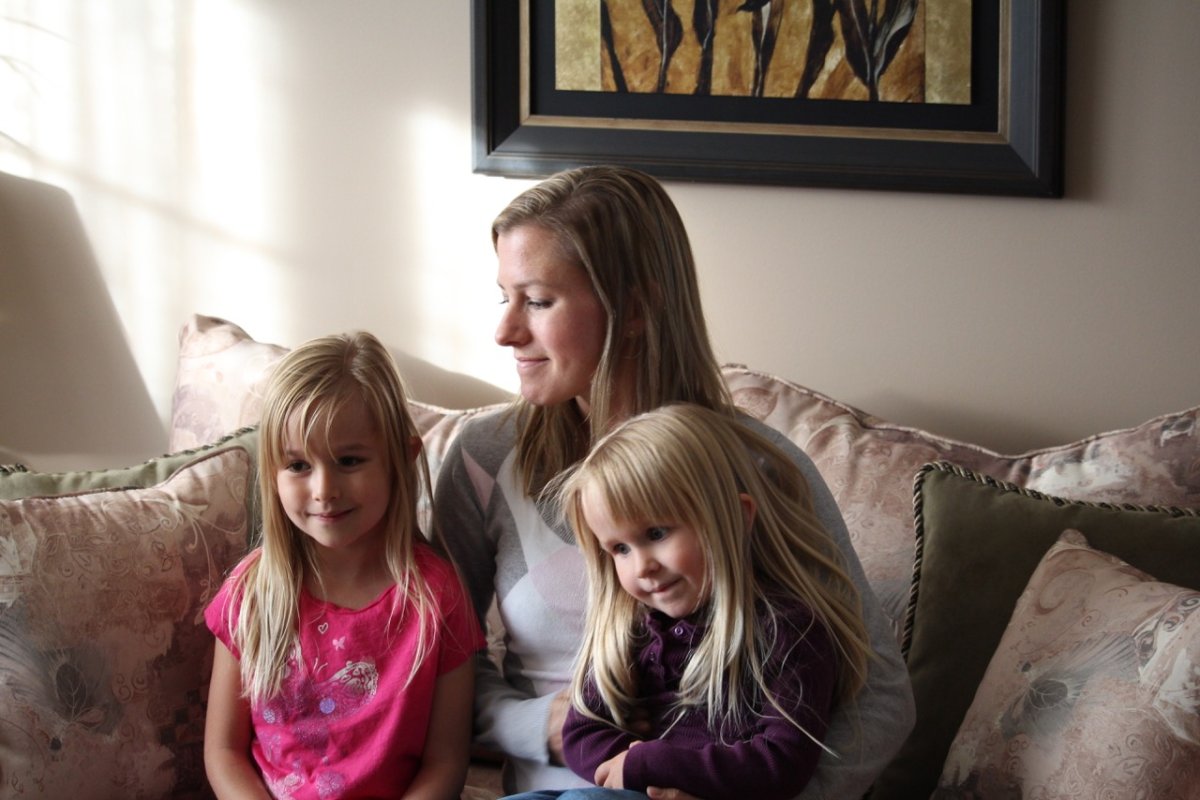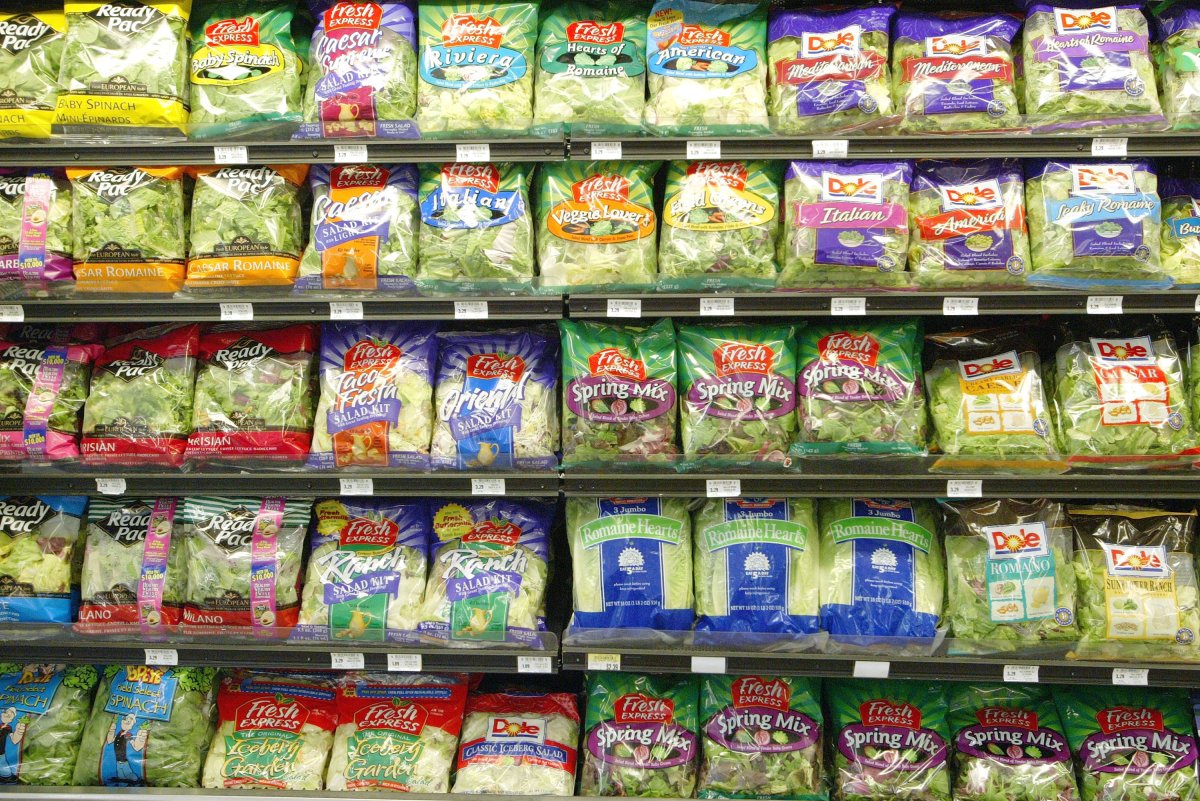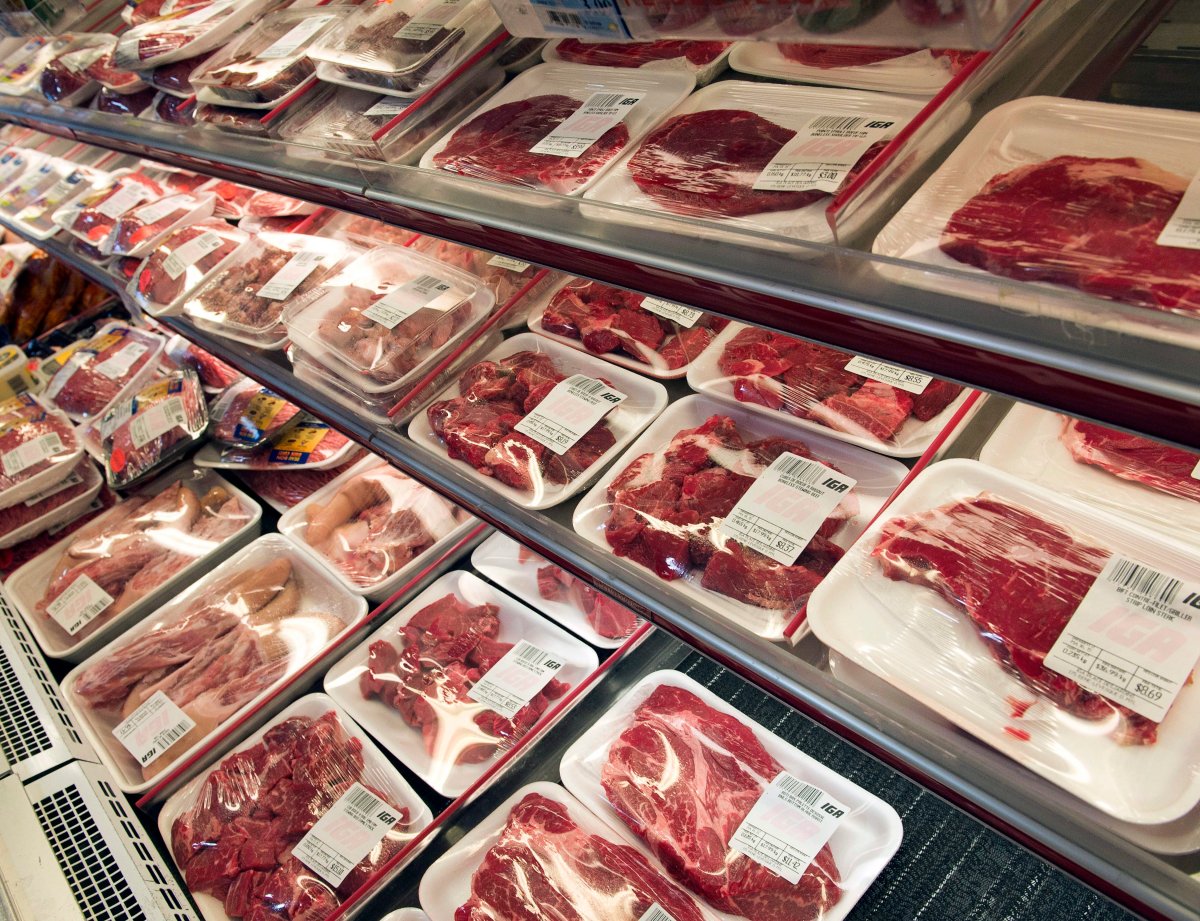Contaminated pork left Andrea Rohachuk curled for hours in agony next to an Emergency Room toilet.

It sickened more than 100 other Albertans – far more than those made ill by the 2012 XL Foods outbreak. Many of the people affected by last summer’s e.Coli outbreak were small children left with failing kidneys.
“It was the worst stomach pain,” Rohachuk recalled in an interview.
“I ended up sleeping on the floor of the bathroom in the hospital. It was so horrible.”
After several hospitalized hours on an IV drip she was sent home, armed with meds that made life bearable in four-hour intervals. In hindsight, she’s just glad her young kids didn’t get sick themselves: They usually share their mom’s meal; it was only by chance Rohachuk relented and let them order fried spring rolls of their own.
“You can imagine how narrowly they missed being brutally sick.”
Almost a year later, nobody knows where the bad meat came from or how to stop a similar e.Coli outbreak from sickening as many people again.
“It is not known if pork was contaminated as a result of swine infected at time of slaughter, or, contaminated via other sources after slaughter,” Alberta Health Services spokesperson Shannon Evans wrote in an email.
“Conditions favourable for pork contamination were identified at multiple points in the pork supplier chain, however, the originating source of the contamination was not confirmed through this investigation.”
More than a month after dozens of Albertans came down with gastrointestinal illnesses thanks to foodborne e.Coli last summer, Alberta Health Services named Edmonton’s Hiep Thanh and Calgary’s V&T Meat as retailers connected with the outbreak. Hiep Thanh was closed by an Alberta Health Services order on Sept. 3, 2014, and re-opened Sept. 18. V&T Meat was closed Sept. 2, reopened Sept. 8, according to the health agency.
Edmonton’s Vinh Fat Foods and Calgary’s Trimming Fresh Meats and Hiep Hoa Asian also recalled products connected to the outbreak.
But the province’s food-safety inspectors never found the slaughterhouse or processing plant where the tainted meat came from.
The retailers involved are part of “a complex pork supplier matrix,” Health Services’ e-mailed statement reads. Each had more than five suppliers and the province doesn’t know which of these five was responsible for the tainted meat.
Asked if not knowing the source of the contaminated pork is cause for concern, Evans wrote:
“The source of illness was pinpointed: it was contaminated pork products. As AHS, our concern is determining the source of human illness, and that has been determined. There is no ongoing concern for public health, related to this outbreak.”
Canada is supposed to have health regulations preventing the food you eat from killing or sickening you and ensuring steps are taken to fix things when something goes wrong. Health Minister Rona Ambrose has said Canada has “the safest food system in the world” and accused those raising concerns of fearmongering.
(Ambrose was unavailable to speak with us for this story. Her office referred us to Canadian Food Inspection Agency President Bruce Archibald, who was not available. We’ve been told a Food Inspection Agency vice-president will be able to speak with us this week. We’ll post that once we have it. )
Update: Ambrose responded to the Global News report in a scrum Tuesday, June 2:
Seventy-eight per cent of Canadians are concerned about the safety of the food they eat, according to an Ipsos poll of 1,005 Canadians conducted for Global News in late May.
READ MORE: Whom do Canadians trust with their food? Local growers get top marks, new poll finds
And Global News has found at least two occasions in the past year when authorities were left in the dark as to what foodborne illness was making Canadians sick and how to prevent that contamination from recurring.
Canada pledged to beef up food inspection in the wake of the 2008 Maple Leaf listeria outbreak and the 2012 XL Foods e.Coli outbreak. But the regulatory backbone to a food safety act passed in 2012 has yet to be put in place. And even as food supply chains become more complex, the Canadian Food Inspection Agency (CFIA) has fewer resources to police it and less of an emphasis on preventing outbreaks rather than responding to them after the fact.
READ MORE: ‘I thought I was going to die’: The lingering impact of listeriosis
Provincial and federal authorities say the necessary checks and balances are in place to ensure your meal won’t make you sick. The union representing food inspectors, and Canadians like Rohachuk who’ve felt firsthand what happens when bad food gets onto their plates, aren’t so sure.
Sickening mystery greens
On April 15, Canada’s Public Health Agency issued a warning regarding “leafy greens” contaminated with e.Coli that had made a dozen Canadians sick in Newfoundland and Labrador, Alberta, Ontario and Saskatchewan the month before.
“A specific product has not been identified yet, and the investigation is ongoing,” the release stated, adding that consumers should wash their produce and food-preparation tools well, and keep vegetables away from raw meat in the fridge.
Almost a month later, the number of sickened Canadians was up to 13, 10 of them in Alberta. But the tainted vegetable’s source, or even the type of “leafy green” involved, was never identified.
“Food safety investigations are a complex process, involving activities such as a review of food histories of the illnesses, identification of foods of interest, trace back and trace out activities of various foods,” a Food Inspection Agency spokesperson wrote in a May 5 email.
“As a result it is very difficult to have established time lines for a food safety investigation, but the CFIA, along with its public health partners, pursue the investigation on a high priority basis.”
On May 25, the Public Health Agency of Canada posted a notice online saying it had closed the leafy green investigation two weeks earlier — without ever identifying what “leafy green” made 13 Canadians sick.
“The Canadian Food Inspection Agency conducted an investigation into leafy greens, however no specific food products were identified as the source of the outbreak,” the notice reads.
It’s a problem when no one knows the source of an outbreak, says food safety expert Doug Powell.
“You want to learn: ‘How did that happen? And where are the failures? And what can we learn from this going forward?’
“… That costs money.”
Increasingly, money is something Canada’s food inspectors don’t have.
An ‘adequate’ food inspection agency
The CFIA vowed to clean up its act after numerous regulatory shortcomings were uncovered in the wake of the Maple Leaf and XL Foods outbreaks. An audit by the U.S. Food Safety Inspection Service, which inspects Canadian plants exporting food to the United States, gave the CFIA the lowest possible passing grade (“Adequate”) and found multiple instances where processing plants weren’t in compliance with safety regulations.
An independent review that found the XL Foods outbreak was “preventable” and due to lax safety inspection recommended the CFIA adopt a stronger “food safety culture;” train its inspectors better; do a better job of enforcing its own rules at the plant level; require better documentation and labelling; and be more transparent about recalls and similar issues.
But the government has yet to enact regulations that would bring its 2012 Safe Food for Canadians Act into force. After consulting with the food industry last summer, the federal government is doing more consultations now, this time with smaller businesses. A spokesperson for Ambrose said there’s no timeline to publish the new regulations but “we’ll take the time to get it right.”
In the meantime, we rely heavily on food processing companies to self-report any contaminations. Inspectors say they’re discouraged from interfering with plant operations if they see a potential safety hazard.
“People are cautioned against interfering with production,” Bob Kingston, president of the agriculture workers’ union, said in an interview. “So that becomes the priority — keeping production going.”
And if a food plant finds e.Coli or other microbial contamination on-site, you don’t find out unless the tainted food hits the shelves.
READ MORE: Are foodborne illnesses on the rise?
Global News went through a years-long access-to-information process to obtain incident reports on e.Coli found in Canadian food plants. When we received printouts and a static PDF of the database containing the reports, much of the information pertaining to safety violations or steps taken to address them was censored, apparently due to privacy concerns of the companies involved.
But when it comes to the safety of your food, Powell argues, corporate privacy shouldn’t be an issue: He argues we need more transparency, not less.
Powell compared it to the pass/fail signs on the windows of restaurants: The more a plant is required to tell the public about its safety record, the more pressure there is to do well.
The way things stand now, he argues, grocery shopping “is all faith-based.”
“We know there are certain bad performers. How is a consumer supposed to know who a bad performer is?”
Canadian Meat Council spokesperson Ron Davidson says there’s no need for the public to know every time there’s a pathogen at a processing plant.
“If it’s not going on the market then I’m not sure what benefit you would have to that,” he said.
“What we need to ensure is that when the product leaves the plant, it’s safe. That’s the bottom line.”
Watch: Is Canada cutting corners on food safety?
Trimming the fat, or cut to the bone?
Even as food inspection authorities are supposed to be beefing up oversight and intervention, the CFIA’s funding and staffing numbers keep shrinking, according to annual reports the agency presents to Parliament.
The Food Inspection Agency’s budget dropped from almost $738 million to a estimated $698 million between 2011-12 and 2015-16 and is projected to drop another $34 million by 2018.
Staffing, meanwhile, is projected to shrink by almost 1,000 full-time positions within seven years: From 6,914 full-time staff equivalents in 2011-12 to 6,148 in 2015-16 and about 5,949 positions in 2017-18.
The federal government disputes this: “There are no cuts to CFIA,” Ambrose told a parliamentary committee last month. Food Inspection Agency President Bruce Archibald told that same committee the number of inspections has increased 19 per cent in the past seven years, and there’s been a “steady increase” in inspectors.
The union representing federal food inspectors has been sounding the alarm on food safety, claiming staffing cutbacks jeopardize their ability to do their jobs adequately.
“The shortage of inspectors means that the CFIA simply cannot meet its mandate to prevent food borne illness,” reads a booklet put out by Food Safety First, a website operated by members of the food inspectors’ union.
(The Meat Council’s Davidson said the group’s members aren’t aware of any reduction in federal inspectors at their plants.)
Agriculture workers union president Bob Kingston says there’s been a shift toward auditing company performance rather than take proactive steps to prevent tainted food from getting onto shelves and into consumers’ stomachs.
Even measures Ottawa touts as bolstering food safety are actually hurting prevention, Kingston said.
Inspection verification teams, for example, were set up to audit the work of Food Inspection Agency inspectors. But Kingston says they’re staffed by people who used to be front-line inspectors — and whose vacant positions were never filled. “The people they’re supposed to be auditing are now short-staffed.”
“The shortages are right across the board. … And the worst part is, Canadians are being lied to about it.”
So, are there enough inspectors? Tough to tell: Even an expert report into the 2008 Maple Leaf listeria outbreak couldn’t figure out whether the CFIA had the resources it needed to do its job effectively.

‘I think they did drop the ball’
The Canadian Meat Council, which says there’s no need for stricter rules when it comes to federally regulated facilities, argues separate rules for smaller, provincial companies – like the ones involved in Alberta’s e.Coli outbreak last year – create a two-tiered system of food safety that splinters oversight and creates a separate, lower (in their view) bar for local food processing facilities.
“Our hearts almost stopped” when federal meat processors saw Alberta’s tainted-meat recall last summer, Meat Council Executive Director Jim Laws told a parliamentary committee on food safety earlier this spring. “E.Coli in pork was unheard of.”
“There still is no lessons-learned document published by Alberta Health Services for this outbreak,” he said.
“We need to know exactly what happened there. A problem in one facility is a problem for everyone, and we don’t want that event to be repeated.”
Ten months after she was sickened by tainted pork whose source we still don’t know, Andrea Rohachuk is much more skeptical of the system supposed to keep her food safe.
The same day Rohachuk ordered that ill-fated bowl of pho, provincial health inspectors were at the Calgary restaurant where she ordered it.
They found dirty cooler doors, dishes, grill and ventilator; poorly stored food; open containers of garbage; and a leaky walk-in cooler repaired with duct tape. They were back two days later, and two days after that. But she heard nothing for ages even after reporting her illness to health authorities.
“I think they did drop the ball. They dropped the ball on the inspections and the rest,” Rohachuk said.
“Why did it take weeks to even track it to that pork? …
With a report from Lauren Khalil






Comments